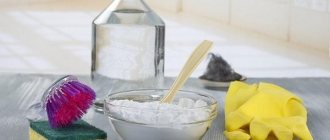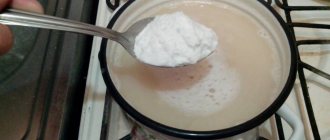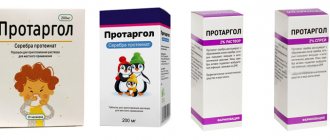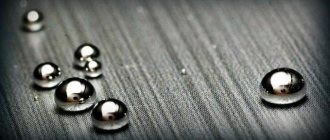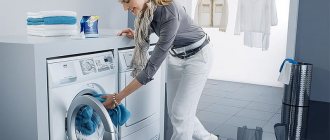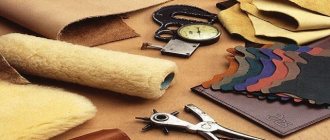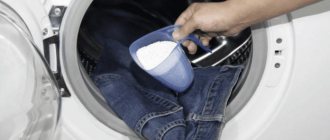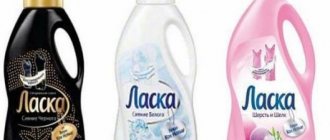Properties of the product
The areas of use of the soap-soda solution are determined based on the effect it provides. It consists of the following aspects:
- antiseptic effect;
- hypoallergenic;
- fight against bacteria, fungal and other infections, pathogenic microflora;
- removal of stains (the structural features of the fabric and coloring are not affected);
- removing dead skin cells of the epidermis, giving softness to the skin, increasing the rate of regeneration, equalizing the water-alkaline balance.
What properties does the solution have?
The individual chemical properties of soap with soda in combination with water allow the ready-made solution to be used for household and even medicinal purposes.
The solution has the necessary qualities, including:
- disinfecting and antibacterial effect;
- fight against pathogens, viruses and various fungi;
- there is no risk of developing any type of allergy;
- a simple way to clean various types of contaminants (without damaging the structure and color of the material);
- Help in removing dead skin particles, softening it, and also in accelerating renewal.
Preparation of the solution
To obtain a one percent solution, the following proportions should be followed:
- 10 liters of water;
- 100 grams of sodium bicarbonate;
- 100 grams of soap (72 percent household soap must be used).
Depending on the application, a higher concentration of soap and soda liquid may be required.
For getting:
- With a 2% solution, the volumes of ingredients (with the exception of water) are doubled;
- 3% - three times;
- 5% – 5 times;
- 10% - 10 times.
A similar result can be achieved by maintaining the initial amount of soap and sodium bicarbonate. It is necessary to reduce the volume of liquid used by 2, 3, 5 and 10 times respectively.
Expert opinion
Advice!
In domestic conditions, preference is given to diluting low-concentrated compounds. In medical and other institutions, a ten percent basis is prepared. It is the basis for obtaining solutions of the required saturation.
How to make a soap and soda solution for cleaning?
You need to dissolve 50 g of crushed soap 65% or 72% (you can use soap with a whitening effect “Friend”) and soda in 5 liters of warm water. The resulting liquid is used to treat walls and floors; a White solution is recommended for washing floors to enhance disinfection if there are no children or animals in the house. If the proportions differ from the recommended recipe, it’s okay.
During general cleaning, the concentration can be increased to 1%, in order to eliminate stains in addition to disinfection, a 2% mixture is used:
- 5 liters of water;
- 100 g soap shavings;
- 100 g baking soda.
This concentration is suitable for cleaning dirty floors, cleaning school desks painted with ballpoint pens and markers.
When using a soap solution, surfaces should be wiped with a clean, damp cloth, because soap tends to leave marks, just as baking soda leaves marks.
For dish washing
The product is prepared in two ways.
The first approach involves using a ladle, pan, and other kitchen utensils made of stainless steel (an alternative is enamel-coated cookware).
The procedure consists of the following sequence of actions:
- grind a standard piece of 72 percent soap (a possible way is to use a kitchen grater);
- Pour 2 liters of water into the selected container;
- bring to boiling temperature;
- add the crushed mass;
- remove from the stove;
- cool;
- supplement the composition with sodium bicarbonate (volume - 6 tablespoons);
- achieve uniformity;
- Place in a container with a tight lid.
Recommended for you:
How to use baking soda against moths
The second approach involves performing the following steps:
- pour 0.5 liters of water into a ceramic container (an alternative is glassware);
- add laundry soap in liquid form, mustard in powder form, sodium bicarbonate (proportions of ingredients - 30 milliliters, 1 and 2 tablespoons, respectively);
- to stir thoroughly;
- pour into a convenient container (preferably with a dispenser);
- shake until fluffy foam forms.
Composition consumption is moderate. To wash a 2-liter pan, it takes about a teaspoon of product.
For washing toys in kindergarten
SanPiN instructions determine the need to use a soap-soda solution to disinfect toys in preschool institutions. The frequency of treatment is twice a day.
A 2 percent solution is to be used. The procedure is as follows:
- pour boiled water into the selected container;
- add crushed soap and NaHCO3 (volumes - 20 grams per liter of water);
- achieve homogeneity by thoroughly mixing;
- Wash the toys using the resulting composition, remove residues with clean water, and wipe.
Daily wet cleaning, processing of various surfaces, tables and other furniture in preschool institutions is carried out in a similar way.
For what purposes is the solution prepared?
This liquid is used for the following actions:
- disinfection of furniture, kitchen utensils, toilets, bathrooms in the house;
- treatment of skin ailments and fungi in both children and adults;
- processing toys, as well as washing any surfaces and dishes in educational institutions and hospitals.
Washing children's clothes
Contamination on clothes of various origins is a common problem. Depending on the nature, the difficulty of breeding may vary.
Sometimes you have to resort to expensive chemicals and the services of specialized laundries. But the solution to the problem is simple and cheap. A simple soap and soda solution can deal with stubborn stains on clothes.
Recommended for you:
How to clean a microwave with baking soda at home
The cooking recipe consists of the following sequence of actions:
- prepare water (optimum temperature – 40 degrees Celsius);
- place sodium bicarbonate and grated soap into it (the required proportions are 10 and 40 grams per 50 milliliters of liquid, respectively);
- achieve homogeneity by thoroughly mixing;
- use as intended.
The resulting volume is enough to process things weighing 4 kilograms.
The hypoallergenic components make the composition suitable for washing children's clothes. Another positive aspect of this stain removal is the ability to treat any fabric.
How to wash soft toys
For machine washing, it is advisable to choose a delicate cycle and detergents intended for children. It is best to choose a temperature of 40 degrees. But here you need to know that indoor dust mites disappear only at 60 degrees and above. When the rinse cycle begins, add fabric softener. It is best to repeat the rinsing to be sure that the remaining detergent is washed away.
Attention: washing in a machine can change the appearance and shape of the product.
Hand washing is intended for toys that have glued parts or are stuffed with something such that water procedures will lead to damage to the product. It can be cotton wool, cereals, shavings, sawdust, etc.
It is best to take a sponge and soapy water to carefully treat these toys. You should not get such toys wet, and it is advisable to immediately dry the areas that you have treated with a hairdryer.
Don’t forget: wash toys that have built-in batteries, squeakers, etc. things cannot be removed, they can only be cleaned.
[adp-shortcode id=”1260"]
Demercurization
A broken thermometer causes panic. And the problem is not the loss of a medical device. The excitement is caused by the understanding of the danger of the substance contained inside.
Expert opinion
Carefully!
Mercury is characterized by toxicity. The excretory system and nervous activity are most at risk. Volatile vapors enter the body with inhaled air. In case of severe poisoning, death occurs.
A frightening prospect can be avoided with basic correct actions:
- clear the room of children and animals;
- isolate from the rest of the room (close the door / curtain the doorway with a blanket);
- moisten a cloth in a solution based on potassium permanganate (1 gram of potassium permanganate is required per 500 milliliters of water);
- put on the threshold (will prevent the transfer of small particles of the substance to shoes and feet);
- ventilate the room (lowering the ambient temperature will slow down the evaporation process);
- minimize contact of mercury with the respiratory tract, skin of the hands and feet (use polyethylene, gloves, gauze bandages and other protection options; the fabric is pre-moistened in a solution of potassium permanganate);
- collect mercury and fragments in a container with water (adhesive tape and a syringe will make the task easier);
- carry out cleaning using manganese;
- After an hour, repeat the procedure with soap and soda;
- Carry out this double treatment for the next 3 days.
The soap composition with baking soda is prepared as follows:
- water is poured into the container;
- NaHCO3 and grated soap are added (proportions are 50 and 40 grams per 1 liter of liquid, respectively);
- achieve homogeneity by thoroughly mixing.
General recommendations for use
Achieving maximum effect and minimizing the likelihood of side effects on the human body is achieved by following a list of rules:
- Prevention of direct effects on the skin. You should stock up on rubber gloves, shoe covers, and other available protection options depending on the area of application.
- Mandatory removal of product residues from treated surfaces. Toys and dishes are thoroughly rinsed under running water and dried. In case of cleaning, the areas are washed again without using the composition.
- Prevention of contact with mucous membranes. Contact may cause irritation, allergic reaction, burns, and increased tearing. The problem is solved by thorough rinsing. If the situation worsens, it is recommended to seek medical examination.
Recommended for you:
How to clean the oven with soda: do it yourself, at home
Other disinfection methods
- More often than others, it is necessary to treat toys for infants, especially those intended for teething. You can simply pour boiling water over them or use special children's disinfectants.
- Soft toys can be washed (unless otherwise indicated on the label) in a machine or by hand with the addition of baby powder. But they can only be used after they are completely dry.
- Bath toys must be washed immediately with warm water and soap and dried well, otherwise mold may grow in them.
- Plastic and wooden toys (dolls, baby dolls, cars, soldiers) are washed with running water and baby soap or baby dishwashing detergent (for example, “Eared Nanny” gel).
How to make baby laundry detergent from soda.
